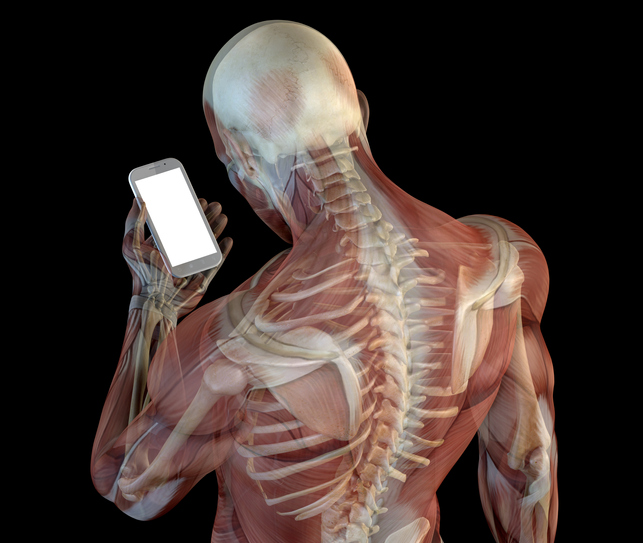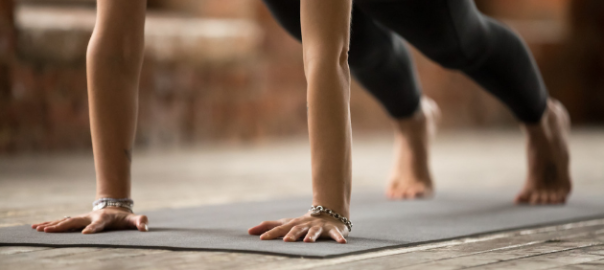Digestive disorders and diseases affect millions of people worldwide and have a significant economical impact comprising health care costs and work absenteeism and presenteeism, in addition to decreased quality of life for sufferers.1 Our food choices are fundamental to digestive health, but there are other considerations such as:
- The impact of stress and
- Poor posture
This blog discusses some of the impacts stress and poor posture can have on gut health and outlines exercises for improving digestion.
The Impact of Stress
In everyday life we are confronted with social, psychological and physiological stressors. Stress is the body’s method of responding to a perceived threat, challenge, physical or psychological barrier. The stress response involves both the autonomic nervous system (ANS) and hypothalamic-pituitary-adrenal (HPA) axis (endocrine system); how the HPA axis responds to a stress stimulus has been discussed recently in our blog on adrenal health.
The ANS is part of the nervous system responsible for the control of bodily functions that are unconsciously directed, such as breathing, heartbeat, and digestive processes, of which there are two main systems:
- the sympathetic nervous system
- the parasympathetic nervous system
The Sympathetic Nervous System (SNS)
The SNS’s primary role is to stimulate the body’s fight-or-flight response. It is responsible for managing real or perceived short-term threats to our survival. SNS stimulation causes vasoconstriction of most blood vessels, the digestive tract, and the kidneys. In effect it slows or shuts down the digestive system, shunting the blood away from the organs not necessary for immediate survival but increasing blood flow to those organs involved in intense physical activity, ready for “fight or flight”.
Chronic activation of the SNS, due to stressful life events, has been associated with the onset or symptom exacerbation of some of the most common chronic disorders of the digestive system, including functional gastrointestinal disorders (FGD), inflammatory bowel disease (IBD), gastro-oesophageal reflux disease (GORD), and peptic ulcer disease (PUD).2
The Parasympathetic Nervous System (PNS)
The PNS has antagonistic functions to the SNS and is often referred to as “rest and digest”. It conserves the body’s energy by bringing bodily functions back to a resting state, particularly after the “fight or flight” response is activated by the SNS. It slows heart rate, contracts bronchial musculature and stimulates bronchial secretions, and enhances gut motility which is important for digestion. Therefore, when the PNS is dominant, digestion can occur effectively.
Vagus Nerve
The vagus nerve (VN) interfaces with the (PNS) and helps to regulate the heart, lungs, and the digestive system. Parasympathetic innervation to the stomach, small intestine and proximal colon is supplied by the vagus nerve.3
It is a mixed nerve composed of 80% afferent fibres (send information from the body to the brain) and 20% efferent fibres (carry information from the brain towards the organs).
In animal studies, it has been found that stimulating the VN increases the release of histamine by stomach cells, which helps stimulate gastric acid production.4 It also promotes the secretion of substances that properly digest food, including the protein-digesting enzyme pepsin, an intrinsic factor which aids the absorption of vitamin B12.
Satiety and relaxation following a meal are in part caused by activation of the vagus nerve’s transmission to the brain in response to food intake.5
Through its afferent nerves, the VN is able to sense metabolites produced by gut microbes and to transfer this gut information to the central nervous system, and then to generate an adapted or inappropriate response.6
It is interesting to note that stress, fatigue or anxiety inhibits VN activation.7
The diaphragm plays a role in peristalsis (the movement of food through the gut). This movement is managed by the VN and therefore squashing the diaphragm, due to muscular imbalances or forward head posture, can affect the nerve signals that pass through it, causing peristalsis to slow down.
Electrical stimulation of the vagus nerve has been shown to reduce inflammation in the gut, improve gut motility, calm the SNS, and improve immune function.8
Poor Posture
Our general posture is often practised without thought. This has a physical effect on the back and spine and it may be having an impact on the optimum functioning of the gut. Forward head posture (FHP) or “text neck” is the anterior positioning of the cervical spine.

It is caused by bad habits, such as spending long periods sitting at a computer or looking down at a mobile phone and tablet. FHP causes the natural curvature of the neck to straighten out. When the cervical curvature is lost, the spinal cord and nerves are stretched, which puts pressure on the top two vertebrae of the spine. What does this have to do with digestion? As previously discussed, the VN is the main nerve that provides the necessary communication from the brain to the digestive system and this starts in between the C1 and C2 vertebrae in the neck. When a person has FHP, they often experience a loss of function of the VN which subsequently can cause digestive issues.
In addition, poor posture constricts the movement of the diaphragm and weakens the abdominal muscles. Sitting and standing correctly, on the other hand, gives the diaphragm space to move properly. Researchers have found that for people with IBS related symptoms, standing upright with good posture has a significant influence on intestinal gas propulsion: transit is faster in the upright position than when supine.9
There are many articles, gut cookbooks and foods all geared towards gut health, but there is surprisingly little in the way of literature on the link between posture and the gut.
Suggestions to Improve Digestion
Lateral Thoracic Breathing
Focus on the breath is one of the eight principles of Pilates. In Pilates we aim for lateral thoracic breathing. It emphasises the lateral expansion of the rib cage while maintaining abdominal contraction during different phases of a Pilates exercise. This type of breathing, as well as abdominal (diaphragmatic) breathing used in Yoga, has been shown to relieve stress and stimulate the PNS and the vagus nerve.10,11,12
Method – lateral thoracic breathing
- Place the palms of your hands on your lower ribs along the sides of the body with fingers from each hand touching
- Inhale through the nose to the sides and back of the rib cage. Focus on sending breath into the entire rib cage, allowing the abdomen to expand slightly. Avoid a shallow breath solely into the upper chest and shoulders.
- Feel the rib cage expanding into the palms of your hands and the fingers from each hand should begin to part
- Exhale through the mouth with pursed lips, with the emphasis on lightly contracting the abdominals in a ‘navel to spine’ movement. The fingers on each hand should now draw back towards each other
The Pilates method is a physical fitness system that was developed in the early 20th century by Joseph Pilates, after whom it was named. It requires total focus and breath control which activates the PNS allowing relaxation throughout the body. In addition, some of the specific benefits Pilates offers are:
- Strengthens the core muscles
- Teaches good spinal alignment
- Helps us become more aware of our posture
- Helps improve flexibility
All the above can be helpful in improving posture, which in turn will lead to better digestion.
Pilates Exercises to try
The digestive system is surrounded by the four muscles of our deep core: the diaphragm, pelvic floor, multifidus (attached to the spine) and transversus abdominis. Effective digestion is aided by the movements of these muscles and hindered by weakness, tightness, and dysfunction. Pilates exercises focus on proper patterning and training of these muscles.
Cat-Cow
Begin on all fours with your hands on the floor directly under your shoulders with your knees directly under your hips. Knees are hip-width apart and arms are shoulder-width apart. Inhale as you drop your chest down a little and you should feel your shoulder blades squeezing together, gaze upwards slightly (feel a stretch in your abdominals), keeping length in your back. Exhale as you tuck the pelvis under, round your back up towards the ceiling, drop the head and hollow the abdominal wall (naval to spine) into cat pose. Repeat 6-8 times.
All-fours twist
Begin on all fours with your hands on the floor directly under your shoulders and your knees directly under your hips. Press your right hand into the floor to support you and lift your left arm out and up towards the sky to twist the torso open to the left with a wide-open chest. Thread your left arm under your right side, through the space below your torso and the mat to twist towards the floor. Feel like you are wringing your torso out like a washcloth. Reach your arm back out and up to the ceiling to begin the next repetition. Perform 10 reps on that side and then switch sides to perform 10 reps on the opposite side.
Shoulder Bridge
Shoulder bridge pose stimulates the pelvic area and colon and therefore elimination.
Lie on your back with your arms by your side. Place the soles of your feet flat on the floor with your knees bent and legs parallel. On an exhale, squeeze the glutes (bottom muscles) to curl your tailbone up and off the floor. Press into your feet as you continue to roll up, one vertebra at a time, to come into a bridge. Try to only use the glutes rather than your back to lift the hips. Inhale and pause the move to lengthen at the top. Exhale to roll back down one vertebra at a time. Perform 10 reps.
This is a great exercise to strengthen and activate the glutes and open up the hips. Inactive glutes can lead to lower back pain, knee pain and a decrease in sport performance.
Mild to Moderate Exercise
Several studies have shown that a post-meal walk can aid digestion. One study in 2008 showed that walking increased the rate at which food moved through the stomach.13 Essentially, walking after a meal may lead to an overall improvement in blood glucose levels and diabetes control, and helps move food through the digestive system more quickly.14 Research has found that mild to moderate exercise stimulates the vagus nerve and thus encourages facilitation of food movement and digestion in the stomach.15
Key Takeaways
- Chronic stress and activation of the sympathetic nervous system may be associated with chronic disorders of the digestive system.
- The parasympathetic nervous system is often referred to as “rest and digest”. When it is dominant, gut motility is enhanced leading to effective digestion.
- The vagus nerve interfaces with the parasympathetic nervous system and helps to regulate the digestive system, heart and lungs.
- Our general posture is often practised without thought which has a physical effect on the back and spine and is likely to impact optimum functioning of the gut.
- Forward head posture (FHP) or “text neck” causes the natural curvature of the neck to straighten out. When a person has FHP, they often experience a loss of function of the vagus nerve which subsequently can cause digestive issues.
- General poor posture constricts the movement of the diaphragm and weakens the abdominal muscles. Breathing exercises, Pilates and other activity can all support posture and digestion.
If you have any questions regarding the topics that have been raised, or any other health matters please do contact me (Amanda) by phone or email at any time.
amanda@cytoplan.co.uk, 01684 310099
Amanda Williams and the Cytoplan Editorial Team
References
- Guarner D et al (2008) ‘MAP OF DIGESTIVE DISORDERS’; DISEASES.
- MAYER EA (2000) ‘The neurobiology of stress and gastrointestinal disease’, Gut;47(6):861-869.
- Browning KN, Travagli RA (2014) ‘Central nervous system control of gastrointestinal motility and secretion and modulation of gastrointestinal functions’, Compr Physiol;4(4):1339-1368.
- Norlén P et al (2005) ‘The vagus regulates histamine mobilization from rat stomach ECL cells by controlling their sensitivity to gastrin’, J Physiol,564(3):895-905.
- Uvnäs-Moberg K (1994) ‘Role of efferent and afferent vagal nerve activity during reproduction: integrating function of oxytocin on metabolism and behaviour’ Psychoneuroendocrinology,19(5-7):687-695.
- Bonaz B et al (2018) ‘The Vagus Nerve at the Interface of the Microbiota-Gut-Brain Axis’ Front Neurosci, 12:49.
- Porges SW (1995) ‘Cardiac vagal tone: a physiological index of stress’ Neurosci Biobehav Rev, 19(2):225-233.
- Borovikova L V et al (2000) ‘Vagus nerve stimulation attenuates the systemic inflammatory response to endotoxin’ Nature,405(6785):458-462.
- Dainese R et al (2003) ‘Influence of body posture on intestinal transit of gas’ Gut, 52(7):971-974.
- Wang S-Z et al (2010) ‘Effect of Slow Abdominal Breathing Combined with Biofeedback on Blood Pressure and Heart Rate Variability in Prehypertension’ J Altern Complement Med, 16(10):1039-1045.
- Guy’s & St Thomas’. Abdominal Breathing.
- Ma X et al (2017) ‘The Effect of Diaphragmatic Breathing on Attention, Negative Affect and Stress in Healthy Adults’ Front Psychol, 8:874.
- Franke A (2008) ‘Postprandial walking but not consumption of alcoholic digestifs or espresso accelerates gastric emptying in healthy volunteers’ J Gastrointestin Liver Dis, 17(1):27-31.
- Reynolds AN et al (2016) ‘Advice to walk after meals is more effective for lowering postprandial glycaemia in type 2 diabetes mellitus than advice that does not specify timing: a randomised crossover study’ Diabetologia., 59(12):2572-2578.
- Wang Y et al (2010) ‘Vagal nerve regulation is essential for the increase in gastric motility in response to mild exercise’ Tohoku J Exp Med, 222(2):155-163.
Last updated on 31st January 2025 by cytoffice



Wouldn’t the psyllium husks in this product cause quicker emptying of the intestines and hence prevent the take up of the nutrients? Further more as the Tumeric only contains a small amount of curcumin what advantage will it be in this product?
Hi Brian,
Thank you for your question on our blog. Psyllium should be taken with a large glass of water which allows it to expand as a gel, providing bulk and helping to sweep through waste products. It is useful both for speeding up and slowing down bowel transit times – so people use it if they have a tendency to constipation or loose movements. Studies have shown its effects on nutrient absorption to be minimal and not of concern.
In regards to our Organic Turmeric Plus product – this formula has been developed to support gastrointestinal integrity and repair. It has not been complexed with a component to increase its absorption so will largely remain and have positive action in the gut. The product is combined with other herbs – gotu kola and cat’s claw. For systemic action we would suggest Cell-Active Curcumin which tests have shown to be up to 285 times more bioavailable than standard curcumin.
I hope this helps.
Thanks,
Clare.
I was so pleased to see the Pilates exercises in the blog as I know them from attending a class but did not know they aided digestion ! I’ll try to practice them every day from now on ( not just once a week at class !) Thanks
Hi,
Where are the references please?
Hi,
The references have been added.
Thanks,
Abbey
Thanks for the article. It would have been an ideal opportunity to also recommend the Alexander Technique, rather than just pilates/yoga type exercises. If people have muscular habits that lead to poor posture – as we all do(!)- then these are only strengthened with exercise, rather than eliminated….so that once back to everyday life (sitting , walking etc) one’s poor habits have been further strengthened by the exercise!! I am a practitioner, having a Cytoplan account and also a very experienced Alexander Technique Teacher. I have seen many people’s digestive issues/ reflux/ stomach cramps etc improve whilst having Alexander lessons.
Thank you for your comments on Alexander technique, where can I find out more, a good source of information?
Give me a ring and . I will be very happy to talk with you about the Alexander Technique. Or read Glen Park’s ‘The Art of Changing” – a great intro to the Alex Tech (I sell copies so if you cannot find one do give me a ring and I can send one).
Best wishes,
Delia
Great blog, drawing attention to our posture in relation to digestion, so commonly overlooked!
Fantastic article Amanda,
Could not have written it better myself. As Karin says posture is so often overlooked in connection to digestion.
I’ve been teaching Pilates Yoga and Tai Chi for many years as well as remedial exercise and nutrition within Chiroporactic care for over 5 years.
This article is a great summary and link to nutrition lifestyle and physiology.
With you permission I will be sharing it along with my own video demonstrations and pictures within my existing client base.
WELL DONE!!!
It’s refreshing to see the strong link highlighted between posture, stress, and digestive health. We often focus solely on diet while overlooking how our nervous system and daily habits like screen posture impact digestion.
Hi Franklin,
Thank you for your comment, we are glad to hear the article was interesting to you.